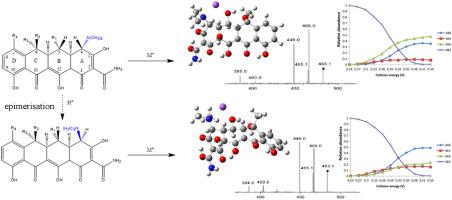Talanta ( IF 5.6 ) Pub Date : 2022-12-16 , DOI: 10.1016/j.talanta.2022.124201 Peixi Zhu 1 , Dandan Chen 2 , Kezhi Jiang 3 , Siqi Zhu 4 , Weike Su 2 , Ann Van Schepdael 5 , Erwin Adams 5

|
Tetracyclines (TCs) are a family of broad-spectrum antibiotics. During the manufacturing process or storage, epimerization of tetracyclines could occur, leading to 4-epimers which are nearly inactive. From an analytical point of view, isomers are often difficult to distinguish. Previously, four pairs of TCs (oxytetracycline, tetracycline, doxycycline, chlortetracycline and their respective 4-epimers) were differentiated by mass spectrometry (MS) through protonated ions. However, they do not follow common rules and so it is still quite difficult to differentiate between them. In order to solve this, the four pairs were differentiated in the current study by collision induced dissociation (CID) spectra of the alkali adduct ions, including lithium, sodium and potassium. In the spectra of the sodium adducts, all studied tetracyclines showed a tendency to form [M + Na–NH3]+ ions, while the 4-epimers liked to form [M + Na–NH3–H2O]+ ions. Meanwhile, energy resolved mass spectrometry (ERMS) showed that all four 4-epimers' sodium adducts had the tendency to fragment at higher energy points. In the CID spectra of lithium adducts of TCs, a similar trend was observed for three pairs, except for doxycycline. For potassium adducts, the fragmentation was found to be less discriminative. As was derived from the 3D model, the four pairs all interact with the alkali metal through the dimethyl amino group at the C-4 position. The lithium adduct species also bound through the hydroxyl group at the C-5 position. If the TCs did not have a hydroxyl group at the C-5 position, they bound with the hydroxyl group at the C-6 position. For the same TC, with an increase of the diameter of the metal ion, the loss of H2O decreased gradually. As sodium adduct ions are common during the ionization process, TCs and their 4-epimers could be differentiated rapidly by ERMS of the sodium adduct ions.
中文翻译:

碱金属加合离子质谱法区分四环素及其 4-差向异构体
四环素 (TC) 是一类广谱抗生素。在制造过程或储存过程中,四环素可能发生差向异构化,导致几乎无活性的 4-差向异构体。从分析的角度来看,异构体往往难以区分。以前,四对 TC(土霉素、四环素、多西环素、金霉素及其各自的 4-差向异构体)通过质谱 (MS) 通过质子化离子进行区分。但是,它们不遵循共同的规则,因此仍然很难区分它们。为了解决这个问题,目前的研究通过碱加合离子(包括锂、钠和钾)的碰撞诱导解离 (CID) 光谱来区分这四对。在钠加合物的光谱中,3 ] +离子,而4-差向异构体喜欢形成[M + Na–NH 3 –H 2 O] +离子。同时,能量分辨质谱 (ERMS) 表明,所有四种 4-差向异构体的钠加合物都有在较高能量点断裂的趋势。在 TC 的锂加合物的 CID 光谱中,观察到三对类似的趋势,除了多西环素。对于钾加合物,发现碎片化的辨别力较低。正如从 3D 模型得出的那样,四对都通过 C-4 位置的二甲基氨基与碱金属相互作用。锂加合物物质也通过 C-5 位的羟基结合。如果 TC 在 C-5 位置没有羟基,它们将与 C-6 位置的羟基结合。对于相同的TC,随着金属离子直径的增加,H 2的损失O 逐渐减少。由于钠加合离子在电离过程中很常见,因此可以通过钠加合离子的 ERMS 快速区分 TC 及其 4-差向异构体。













































 京公网安备 11010802027423号
京公网安备 11010802027423号